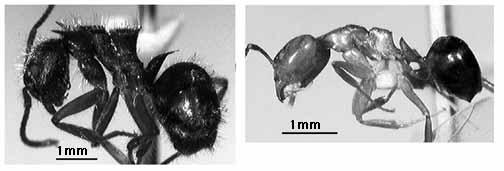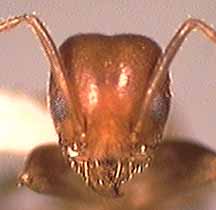
| return to guide introduction | go to genus list |

|
Uniform habitus; polymorphic; petiole with well-defined dorsal node and distinct posteroventral lobe (contrast Dolichoderus, Linepithema, Tapinoma). Arboreal; common.
|
 |
An Old World genus recently discovered in Costa Rica, the first record of the genus in the Americas. Superficially similar to Brachymyrmex in the field. Differs from Azteca in the short dorsal face of propodeum. Differs from Tapinoma in the presence of a scale-like petiolar node.


Habitus variable; monomorphic; hypostomal teeth present (on anteroventral margin of head capsule near mandibular insertion). Arboreal; common.

Uniform habitus; monomorphic; unique conical projection on propodeum. Nest in soil; common in open disturbed areas.

Two species in Costa Rica; monomorphic; petiolar node visible and scale-like, with no posteroventral lobe (see Azteca); long hairs projecting from clypeus, extending over closed mandibles. Occur in highly disturbed open areas.
LINEPITHEMA

Uniform habitus; monomorphic; petiolar node visible and scale-like, with no posteroventral lobe (see Azteca); hairs projecting from anterior clypeus not as long as closed mandibles. Uncommon; occur in mature wet forest and open disturbed areas .

Uniform habitus; monomorphic; petiolar node very low and anteriorly inclined (appearing absent), petiole often hidden under gaster and not readily visible. Arboreal, house pests; common.
|
 |
The genera Tapinoma and Technomyrmex both have the petiolar node reduced or absent. Tapinoma has four dorsal tergites on the metasoma posterior to the petiole; Technomyrmex has five. Technomyrmex fulvus is the only species of Technomyrmex known from Costa Rica; it builds small carton nests and is very rare. Technomyrmex albipes is a widespread tropical tramp species that could occur in Costa Rica, but has not been reported yet. Technomyrmex albipes is dark brown; T. fulvus is orange.
Page author:
John T. Longino, The Evergreen State College, Olympia WA 98505 USA. longinoj@evergreen.edu